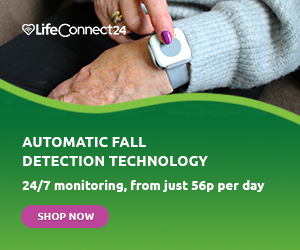Age-related cataracts are just one of many eye conditions which can lead to blindness among older people. There are currently 360,000 people officially registered as being blind or partially sighted in the UK, a figure that may increase due to our ageing population.
In today’s post, we’ll take a closer look at age-related cataracts, including the symptoms and treatments available.
What are Age-Related Cataracts?
Age-related cataracts are a very common eye condition. In fact, according to Specsavers, there are around 2.5 million people aged 65 or over that have suffered from some degree of visual impairment due to the condition.
The condition causes the lens inside your eye to develop cloudy patches which become bigger over time. The NHS explains:
When we’re young, our lenses are usually like clear glass, allowing us to see through them. As we get older, they start to become frosted, like bathroom glass, and begin to limit our vision.
The knock-on effect of this is that you may begin to have blurry and misty vision, and if left untreated you may become blind. Age-related cataracts commonly appear in both eyes, although not always at the same time.
Symptoms
As mentioned above, the main symptoms of age-related cataracts are that you will suffer from blurry, misty or cloudy vision. However, there are other signs to watch out for as well:
- Suffering from double vision.
- Bright lights being uncomfortable or dazzling to look at.
- Difficulty seeing in dim or very bright lighting.
- Colours becoming faded.
- Seeing halos around bright lights, for example, car headlights.
- If you wear glasses, you may feel your lenses are dirty and need cleaning, even when they don’t.
The condition develops over many years and at first you may not notice any symptoms. Unlike some other eye conditions, age-related cataracts will not cause any pain to your eyes or create any irritation or redness.
If you suffer from any of the symptoms mentioned above, you should see an optician as soon as possible.
Diagnosis
When you visit your opticians, they will proceed with a series of eye tests. This includes a visual acuity exam, which will measure how well you see at various distances. If your optician believes that you may have age-related cataracts, you may be referred to an ophthalmologist for further tests and treatment.
Treatment
The only long-term solution for age-related cataracts is surgery. A short-term solution would include being prescribed stronger glasses and having brighter reading lights, but this will only help for a brief period of time.
If your condition is having an adverse effect on your daily life, including driving and your occupation, then surgery, provided on the NHS, is the only option. The operation will involve replacing the cloudy lens inside your eye(s) with an artificial one. The procedure is the most common operation performed in the UK, however, as of 2019, according to The Guardian it has been reported that people with poor eyesight are having to wait longer for operations, which is putting people at an increased risk of falling.
Before the procedure takes place, you’ll be referred to an eye doctor for an assessment. During this assessment, various measurements will be taken of your eyes and eyesight. You’ll also be given the opportunity to talk about the operation, including the risks and the recovery time.
The procedure itself is often carried out under local anaesthetic and takes between 30 and 45 minutes to complete. It’s highly likely that you’ll be able to go home on the same day, however, if you have age-related cataracts in both eyes you’ll need a second operation. This usually takes place six to 12 weeks after the first procedure.
During surgery, the surgeon will make a tiny cut in your eye in order to remove the affected lens and will then replace it with a clear plastic one. On the NHS, you’ll most likely be offered a monofocal lens, which has a single point of focus. This means the lens will be fixed for either near or distance vision, but not both.
If you’re used to using one eye for distance and one for reading, which is called monovision, you can ask to stay that way. This usually means you’ll get a near sight lens fitted in one eye and a long-sighted lens fitted in the other eye.
The risk of any serious complications from cataracts surgery is very low, and any common complications can be treated with medicine or further surgery. There is a small risk (1 in 1000) of permanent sight loss in the treated eye.
Recovery from Surgery
As mentioned previously, it’s highly likely that you’ll be able to go home on the same day as your operation. It may be that you have a pad or plastic shield over your eye when you leave the hospital, which should be kept on for the first day.
Feeling in your eye should return within a few hours, however, it can take a few days for your vision to fully return. Common short-term side-effects of the procedure include:
- Double vision.
- Blurred vision.
- Watering.
- Grittiness.
- Red or bloodshot eye.
These side-effects should improve within a few days, however, full recovery is stated as between four and six weeks. If you need new glasses, you won’t be able to order them until your eye has completely healed – usually after six weeks.
During those first few recovery weeks, you should ensure that you use your eye drops as instructed by your eye doctor and use your eye shield at night and when you’re washing your hair for at least seven days. Other things to remember during your recovery include:
- Avoid swimming for up to six weeks.
- Don’t rub your eye.
- Don’t allow soap or shampoo to get into your eye.
- Don’t do any strenuous exercises or housework.
A full guide to using your eye-drops can be found on the NHS website.
Driving
If you suffer from age-related cataracts in both eyes you need to inform the Driver and Vehicle Licensing Agency (DVLA). You only need to inform the DVLA if you have the condition in one eye if you also have another medical condition in the other eye or if you drive for a living.
After surgery you should not drive until you have been given the all-clear from your doctor.
Causes of Age-Related Cataracts
Although it’s not entirely clear why you’re more likely to develop the condition as you get older, there are some things which can increase the risk overall. These possible causes include:
- Smoking.
- Diabetes.
- An eye injury.
- Long-term use of steroids.
- Excessive drinking.
- A family history of cataracts.
To learn about ways of protecting your eyes, please see our helpful guide.
Personal Alarm Information
For more information about our life-saving personal alarm service, please get in touch with our friendly team on 0800 999 0400. Alternatively, complete our contact us form and we will get back to you as soon as possible.



Leave A Comment